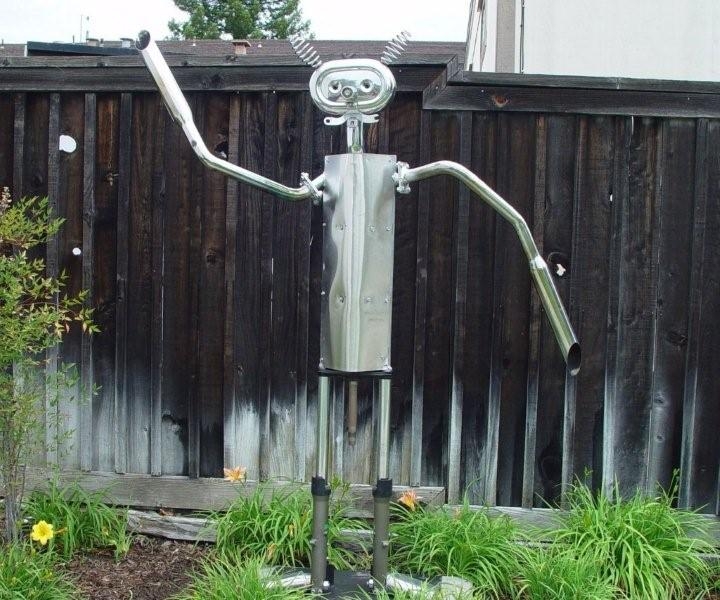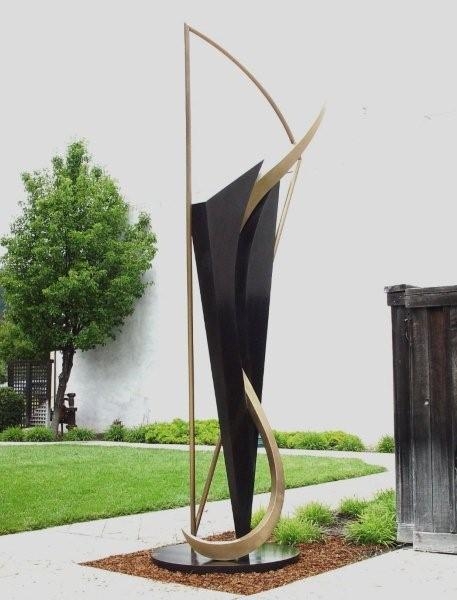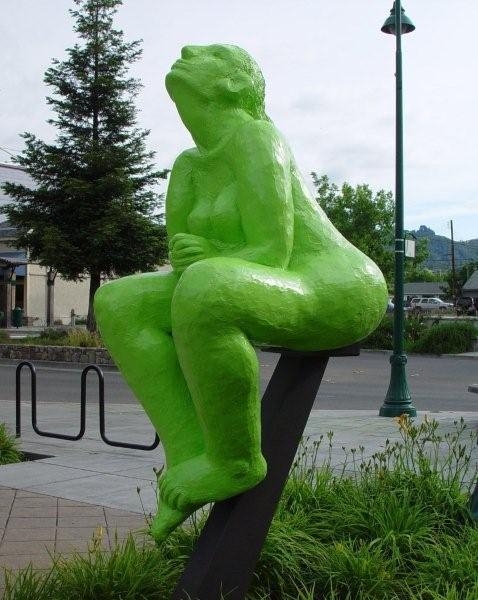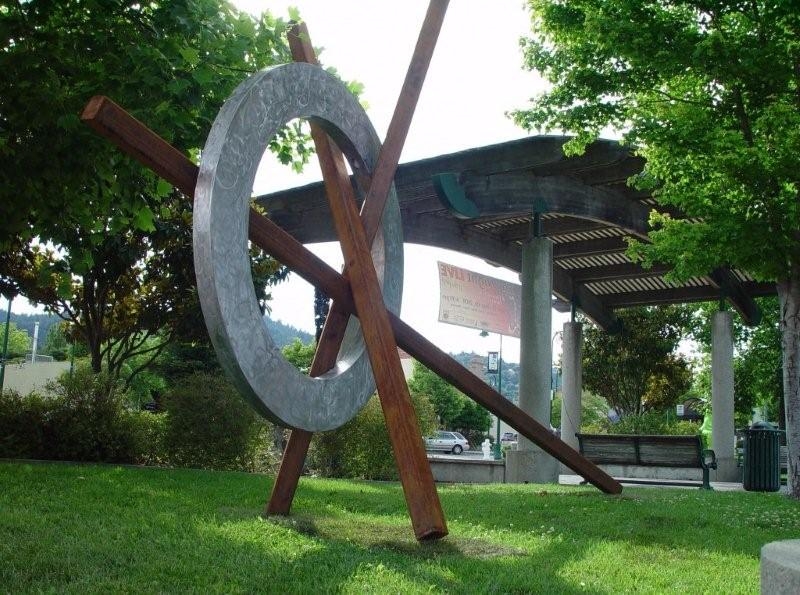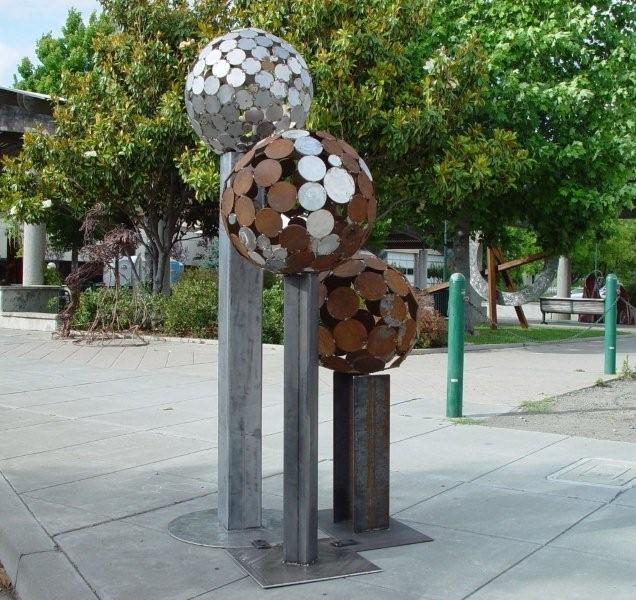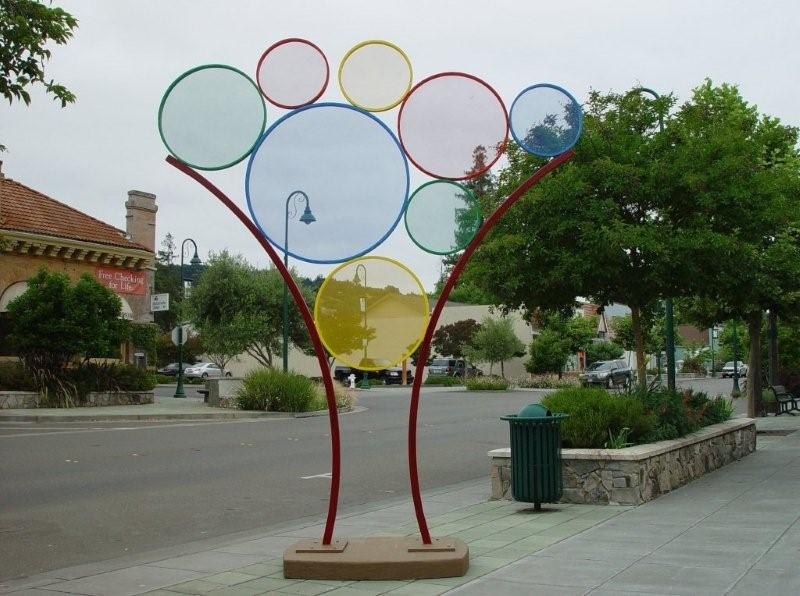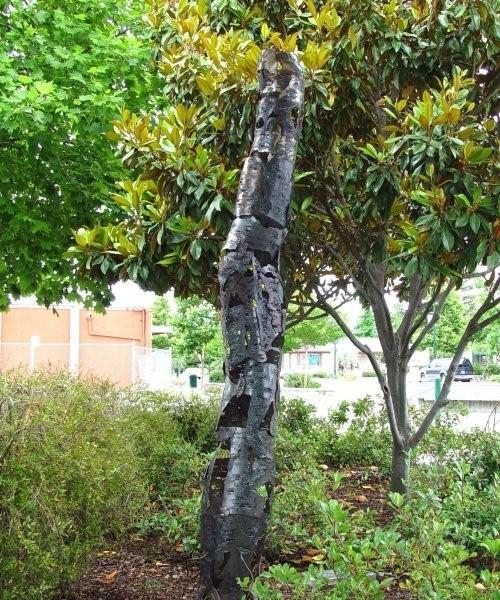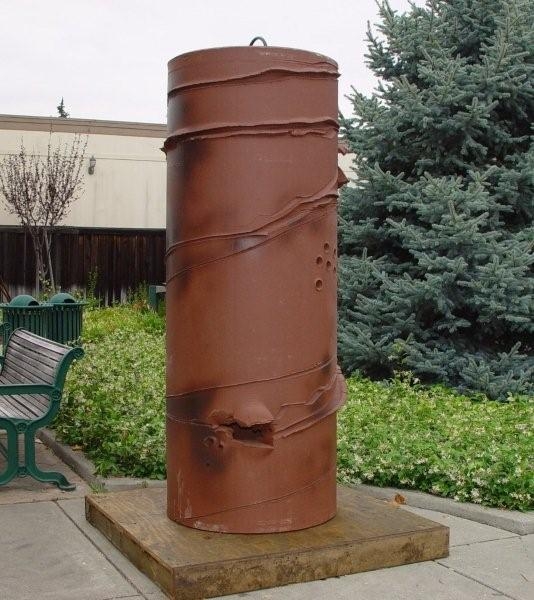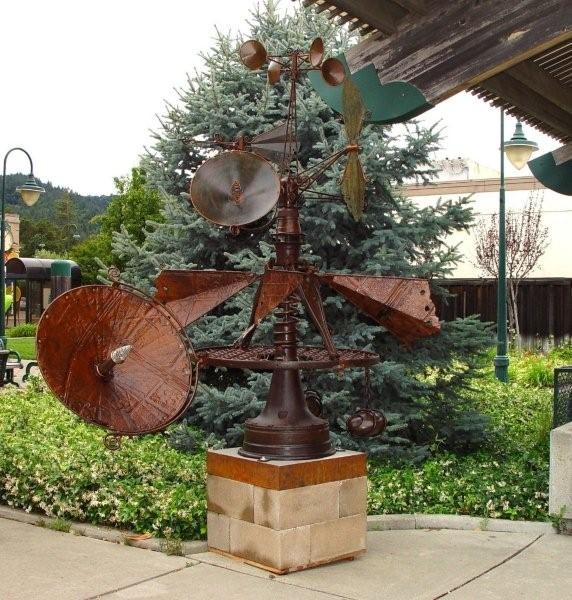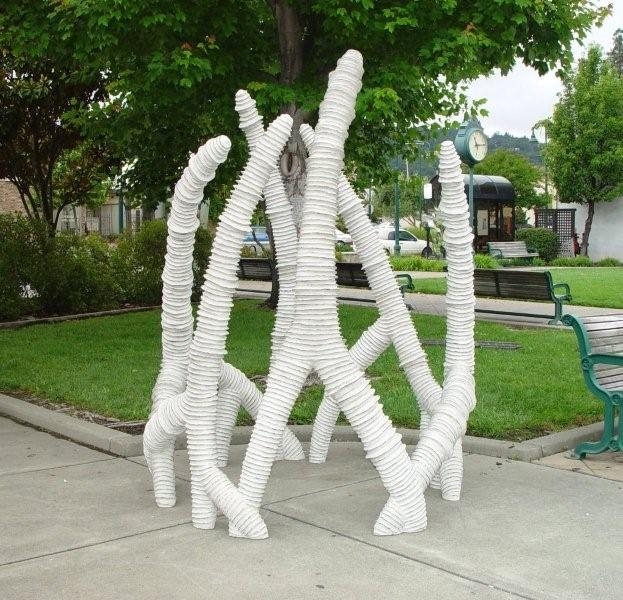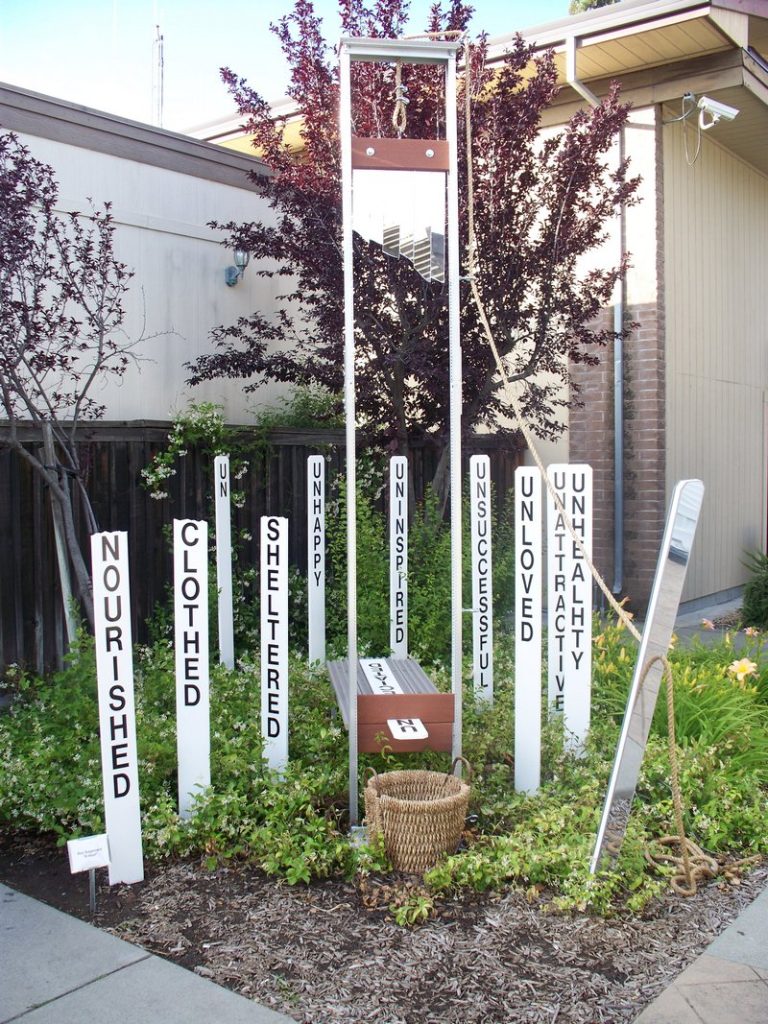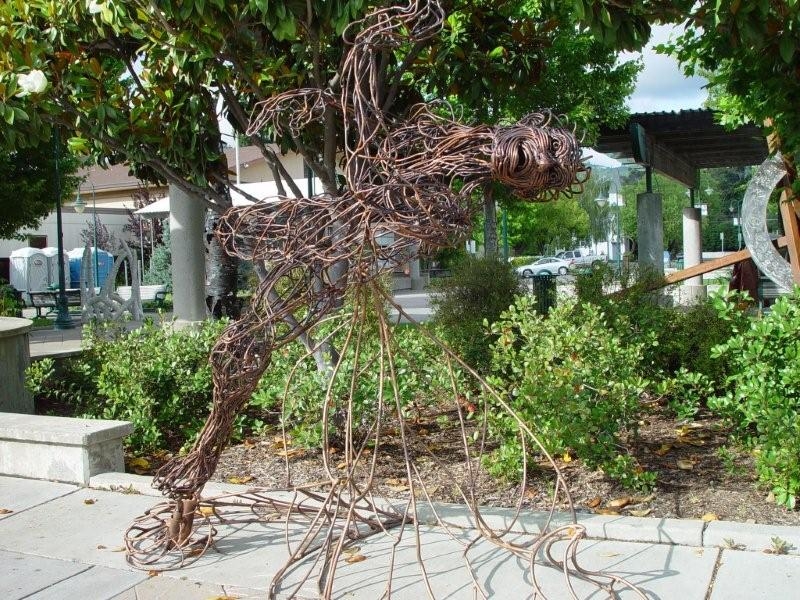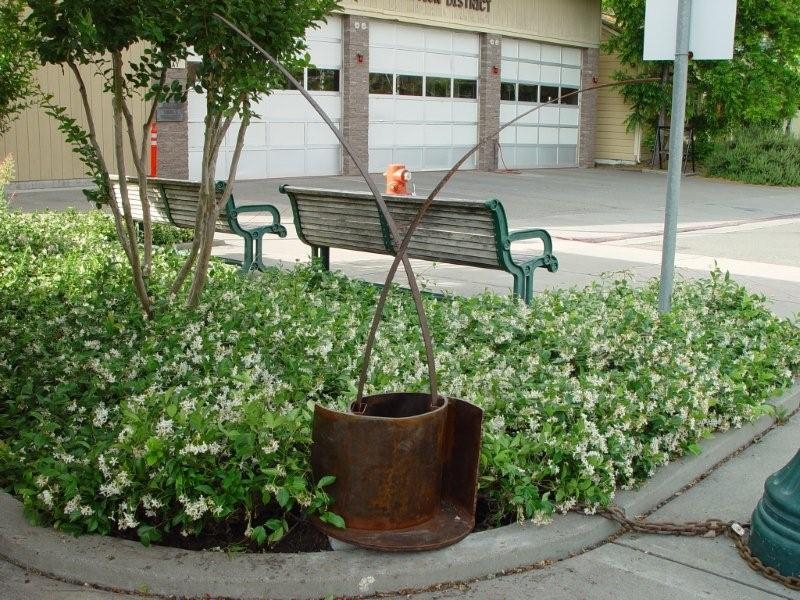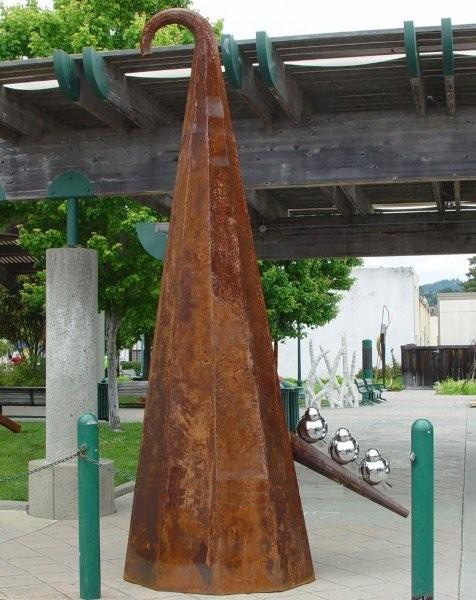2009 marks the 7th year of celebrating public art with the Annual Cloverdale Sculpture Exhibit. The exhibit enlivens our plaza each year for the benefit of the local community and those visiting our town, while also contributing to our reputation as an arts destination in Sonoma County.
A panel of 3 judges selected “Shadows of Eternity” by Boback Emad as “Best of Show” and presented him with a cash prize at the opening reception on June 6th. “Spires + Pinnacles” by Frank Miller, “Totem” by Joseph Styles, and “Pinnacles” by Steven Brown were each awarded “Honorable Mention”.
3-D Edddy
CromptonDragonOsarus
“CromptonDragonOsarusis” a piece inspired by a drawing by 4 ½ year old Colin Crompton. Edddy has been on a life-long mission to create new value from discarded objects, and CromptonDragonOsarus is a prime example of this work. “I create with what’s at hand,” he said. “In the late 70’s and early 80’s, due to a lack of art education funding in our schools, I began to provide art enrichment for my family. Being of modest means, I used household junk, used lumber, and found objects to construct sculptures. We gathered these materials and waited for the objects to speak to us, telling us what they wanted to be.”
Edddy began “CromptonDragonOsarus” by building the armature from salvaged lumber. Shaping the wood with a circular saw created the roundness for the scales, which are fashioned from sheet metal. He used a bicycle for the eyes, and enlisted his mother to make the stained glass features. Bicycle handles, tin cans, stove pipe, bottle caps and jar lids were all incorporated, and thrift-store forks and spoons became the “teeth”. Assembly took place at the Chops Teen Center in Santa Rosa, where the staff and teens were all delighted to participate, and to learn about both art and creative recycling from Edddy.
Edddy is passionate about new uses for junk. “Our present generation threatens to become inundated with the accumulation of junk, and as was the case of the impressionists venturing out of the old school academy of art, the “Now” generation must do something constructive with our present time. As the population increases, more and more junk accumulates, and thinking people find themselves identifying with this new condition. Therefore, Junk Art is putting the nearly impossible articles together to make new sense for communication in the reality of our times.”
Joe Bologna
Harleyzuki Motomana
“Harleyzuki Motomana” is a human-scaled sculpture comprised of recycled scrap steel parts for a Harley-Davidson and a Suzuki motorcycle. The dominant finish and materials are stainless steel and chromium plating. In this work, Bologna set out to dispel the aloofness often associated with motorcyclists, and the sometimes cold persona of steel and chrome. His success in this endeavor can be witnessed in the friendly, uncomplicated personality of this piece.
Steven Brown
Pinnacles
The “Pinnacles” set of four pieces were cut from an old burned-out redwood stump, which Brown had been looking at for years before deciding how to cut into manageable sizes. He selected four pieces which can be arranged in any number of positions to work as a group. The flame-colored redwood grain shimmers in direct light, and appear more solid in shade. Seen from a distance they suggest wave-hopping whales. “Pinnacles” is fast-becoming a favorite with those who love to interact with it – indeed few are able to pass by without reaching out to touch the rich tones and smooth carvings of the wood.
Steven Brown’s designs are suggested to him by the stumps , and he explained his process as follows: “Normally, I will look at a rough stump until the sculptural possibilities become apparent to me. The direction I take is suggested to me as I carve into the core and respond to the grain, rather than imposing a particular shape to conform to my idea”. He went on to elaborate “after considering the sculptural potential of a redwood stump, root or burl, I begin by roughing out the form with a chainsaw, then use sanders, rasps and chisels to finish. I follow the lead of the natural grain and structure – normally it’s a process of simplifying to the core. The pieces are finished with spar varnish or log oil to seal against the elements, and to hold the color of the redwood. On some pieces I use furniture glides on the underside so they’re easier to move on a floor or deck”.
Biis Burwell
Syncronetic #4
Burwell’s sculpture draws its vitality from his own reverence for nature, and his fascination with the opposing forces of geometry and entropy that underlie the structure of the physical world. He is intrigued and inspired by the delicate balance between order and chaos, growth and decay of all matter, and reveals that “creating sculpture provides me with a deeper connection to the beauty inherent in nature and ultimately, to the Divine”.
.
Burwell feels great fortune in living and working in the Sonoma County foothills, where he finds that his daily connection with nature provides him with a foundation to sculpturally express dynamic tension in his work. He elaborates “I attempt to accomplish this balance between order and chaos, growth and decay through the graceful juxtaposition of form and line in opposing abstract elements. Often, a sculpture is composed of a central angular shape of substantial mass, intertwined with more delicate, rounded sculptural forms. In other pieces, the relationship between hard angles and gentle curves occurs within an individual shape or shapes. Successful artistic synthesis of these forms results in sculpture infused with energy.”
Burwell expresses a strong preference for steel, stainless steel, and bronze in his works because of their permanence and inherent beauty, as well as their duality of character. “They are, at the same time, utilitarian yet graceful, strong yet yieldingly flexible, and have the ability to evoke a variety of textures – from naturally rusted to smooth and gleaming, from a soft natural patina to deep brown or black.”
m.c.Carolyn
The Listener
M.C. Carolyn’s “The Listener” has attracted a lot of attention to itself and other exhibits at this year’s 7th Cloverdale Annual Sculpture Exhibit. Art comes alive when it gets people thinking and communicating – “The Listener” is functioning very well indeed in this respect.
This large sculpture presents a woman seated on a pedestal and listening to the world around her. She patiently sits waiting for sounds of laughter, joy, music and the magic of the world. MCC has chosen to portray “The Listener” in vivid green, a color that matches the new leaves of Spring.
“The Listener” is created using a new medium invented by MCC: an interior welded steel armature is surrounded by the carved foam form. This foam is a new industrial high density material used within the building industry and road construction. MCC finds this new medium liberates her from the restrictions of her traditional medium of stone.
Her subject matter is usually based on the human figure, with the attention being focused on movement and human conditions. What is this person doing? Why? Is he/she rising up, bending over, angry, loving reclining? MCC bestows each piece with so much more than just a beautiful figure. “The Listener” follows in this lineage.
Boback Emad
Shadows of Eternity
“Shadows of Eternity” portrays memory, and its allusive, interpretive nature. The linear elements move in very different directions, and with differing vantage points. These differences come together in one moment, or memory. The ring, and the space that it contains, exposes the relationship of these diverse participants at a given moment in time. Indeed, a memory that is shaped and supported by the diversity that created it. The piece is composed of a stainless steel ring and Core-ten steel square tubing. Core-ten is a rust-colored steel with nickel, providing a natural deep red finish that will not rust beyond the surface.
In his own life, Emad is always searching for those moments that connect us to beauty. “Shadows of Eternity” reflects his passion for creating dynamic, large-scale sculptures that explore that beauty through an abstract expression of relationships, as opposed to a realistic imitation of nature. Emad sees large, outdoor spaces as “huge rooms” in which he is seeking to create drama and focus. He sees it as his challenge to create works that are dramatic enough in form and scope to combat the size and distractions of large outdoor sites.
Peter Forakis
Spheres
Geometry has always fascinated Forakis and inspired his work. “Geometry … is a natural law that exists not only in my thinking and my blood, bones, and marrow, but in the universe and all its matter”.
In the 60’s, Forakis formed the “Park Place Group” an artist co-op encompassing sculpture, painting and music, in New York. The group members found focus in their shared interest in geometry and complex space. It was an art experiment, and as the group’s principal “geometer”, Forakis was not satisfied with thinking of sculpture as three-dimensional. Instead, his work sought to find a door into the fourth dimension, an absolute realm of pure visual sensation and meaning, venerated as the holy grail by early abstractionists.
Forakis is an unconstrained artist who, driven by his boundless curiosity, has always been willing to cast aside the rewards of the singe signature style favored by the art market. The best known and most influential of Forakis’s work are derived from a unique personal understanding of complex geometrical space. This is illustrated in large commissions such as his monumental Gateway in Atlanta, which towers 100’ tall and 200’ wide, and Tower of Lakota, Williams College in Massachusetts.
After 50 years of experimentation, his fascination with geometry is as vital as ever. “I revisit, revise, and rework concepts and techniques that have influenced the last 50 years of my work. I continue to explore materials and the possibilities of form that they suggest and permit. Each material dictates the next phase of curiosity that is the driving force behind my creativity”.
Gerard Kirk Harris
Equilibrum
“Equilibrium”, by Gerard Kirk Harris, is designed as a sculptural-painting, interacting with and framing the sky and all the elements around it. It can be seen on the sidewalk near City Hall all summer long.
Harris likens sculpture as akin to working with a light bulb: a sculpture will influence the space it is in by projecting its character, just as a light bulb projects light. His sculptural- paintings take this one step further. By “painting on landscape”, the pieces impact the space more directly, by affecting one’s view of the landscape. The pieces are primarily two-dimensional, and are as much paintings as sculptures, so he calls them paintings. They utilize transparent and open areas in the design to allow the landscape to show through and enter the piece. The transparency also affects the view of the landscape by tinting it a new color or adding a texture. The paintings are balanced with the landscape to create an interplaying composition. Even so, the balanced composition will change as the day progresses and the lighting changes.
Harris designs his sculptural-paintings with the intended landscape in mind. A more dynamic landscape makes for a more dynamic painting, and a more powerful painting design draws the eye to the painting, while a simple, open design draws the eye through the painting to view the tinted landscape. The color tinting acts like the French pointillist principle, where color is added, not removed as in a filter. The viewer still sees the landscape in full color, but it is tinted by the screen. This creates a direct relationship between the landscape and the sculptural-painting.
“Equilibrium” was designed with children in mind, interacting with the environment and using bright colors and fun shapes. The screens were designed to be high, giving it a lot of interplay with the sky. Clouds, clear blue sky, sunrises, sunsets and rain all influence this work. Rain in particular will fill holes in some areas with water, forming patterns that give the painting still another dynamic, reflecting and refracting sunlight and street lights.
Beth Hartmann
Trunkated
Beth Hartmann’s “Trunkated” nestles into the landscape at the entrance to the plaza, where it looks completely at home with the trees and other vegetation. “Trunkated”, constructed of pierced steel segments, is welded together to leave holes to see into and through to the other side. Hartmann’s sculptures reflect the feelings left in her after she has viewed objects in nature. Using her own techniques and alternative reflective or translucent materials, she constructs objects which work to provide viewer reaction. “All of us are worried about the vegetation in our warming environment” Hartmann says. “This hard steel sculpture speaks to hope about the hardiness of our trees, and their beauty, even as they go through decay.”
Hartmann’s themes involve the environment and health. “We create an industrial environment, and then, with our fragile protective mechanisms, attempt to live in that environment,” she states. “We also subject coexistent organisms to our industrial environment and then react, often adversely, to what we have changed. By folding, pushing, piercing, welding, and bending metal or other plastic materials, I construct shapes which are reminiscent of birds, waves, and other forms from nature.”
Joe Hawley
AZ Twister
Cloverdale artist Joe Hawley is back in the plaza this year with an imposing new work, “AZ Twister”. Inspiration for “AZ Twister” came from the sight of a dust devil twisting its way across the Arizona landscape. These rhythmic spirals, created by forces of the wind and dust, struck a chord with Hawley. By raking up the side of a rotating wet clay cylinder, a spiraling dynamic transformed a static element into an enduring twister. The resulting form of “AZ Twister” can be seen as a metaphor for the turbulence of our times, or indeed as the rhythm of life itself.
The 1800 lb terra cotta sculpture was created at the Mission Clay Company’s Phoenix Arizona facility.
Hawley was one of several well-known ceramic artists invited to work in collaboration with the Mission Clay to produce a series of experimental sculptures. The art and industry workshop was coordinated by Brian Vansell, artistic director of Mission Clay, and was a feature exhibit of the 2009 Conference on Education for Ceramic Arts (NCECA). Hawley first worked with Mission Clay back in the 1970s at their Freemont California facility.
Frank Miller
Spires & Pinnacles
“Spires + Pinnacles” is inspired by the work of Russian-born American artist Louise Nevelson. After a recent visit to the Louise Nevelson retrospective, Miller was inspired to depart from his well-known bass-relief wall pieces into free-standing three-dimensional work. This new body of work continues to reflect Miller’s fascination with the industrial detritus of our culture. He finds the unseen beauty in everything from abandoned factory sites to the minute interior mechanisms of discarded appliances. His rich palette of earth tones and carefully calibrated surface textures mirrors the ambient patina of rust and decay that he resurrects into works of great harmony and beauty. Miller’s continued exploration of the dialogue between interior and exterior space propels the viewer into the contemplation of the past, the present, and the future. “Spires + Pinnacles” is made from found objects, triple coated with iron paint and rusted.
Nevelson’s words “art was all that mattered to me, at all times, right from the very beginning” so equally apply to Miller. As a child in New York, Miller visited the Metropolitan Museum of Art with his father. He was immediately smitten with the Rembrandt Gallery, his first exposure to masterful art, and he knew immediately that to be an artist for the rest of his life was set permanently into his psyche. He attended the School of Visual Arts in New York City and has lived a life of art ever since.
Seth Minor
Wire Man
Seth Minor’s “Wire Guy” brings welcome interest to the blank city wall on the north side of the plaza this year. This wall became the perfect placement for Minor’s work, which is comprised of a single wire and was designed to be hung on a south-facing wall so as to cast a three-dimensional shadow. Minor’s wire pieces are made from a single wire, and tools are never used in their construction. The shadow is an integral part of the design, becoming a secondary drawing. Similar, but ultimately different from the wire, this secondary drawing transforms throughout the course of the day, and often becomes the main focus, more interesting than the piece itself.
Installation of each wire piece becomes a work of art in and of itself. By their nature, Minor’s pieces must overhand the roof by at least 2 feet to accommodate the all-important three-dimensional shadow. As such, each installation calls for a customized hanging mechanism that uses the available framework of the building while circumventing the always-present obstacles with grace.
Minor’s main influences stem from growing up in a summer community that was deserted each winter. Those winters left him much time to wander, speculate, and fabricate. He developed his imagination by attaching narratives to empty houses and the woods that stood about them. He began his artistic career with a stint in photography, but moved to sculpture as he became dissatisfied with observing and sought a form of participation. Soon, he would begin attaching narratives to his sculptures. As he fashioned sculptures around people, places, or circumstances, real or imagined, it always came down to issues of storytelling, and finding the pieces of truth between the lines of the story. From this point, he incorporated video into his work, which he sees as a way of sculpting images. Soon he was adding music too. Minor is a diversified artist who continues to experiment with combining video, music and sculpture into his installations.
David Mudgett
Face Your Fear
Sculptor David Mudgett has established himself as a favorite of many within the Cloverdale community. This year he returns with a 6 feet high, 500 lb steel and stone spider, entitled “Face Your Fear”. Mudgett believes that spiders have traditionally been given a bad rap. Often needlessly destroyed out of fear, they could benefit from a spokesperson in their defense.
“An intricate strand in the web of life, spiders serve us in many ways,” Mudgett elaborates. “As a natural combatant against garden pests, spiders also reduce the number of disease-carrying insects in our communities. Recent research in the realm of spider venom has shown promise in the treatment of everything from neurological disorders to bioengineering of pesticides.” It is the sincere hope of David Mudgett that “Face Your Fear” will act as an ambassador, provoking the viewer to face his or her fears by looking past the stigma and realizing the true magnificence of these creatures.
Martin Munson
Wind Monometer
Martin Munson returns to the Cloverdale plaza this year with “Wind Monometer”, a kinetic sculpture with 12 moving parts. Munson’s kinetic works are intended as environmental interpretive “tools”. Sculptural mass in motion is a metaphor for harnessing and utilizing natural resources. His work addresses the success and failure of man’s technological prowess versus Mother Nature’s continuances.
Munson responds to his environment as a resource as well as the collective affect of his life’s experience. His materials are mostly recycled. The experience of technology and reclamation is visible in his sculptures, creating contrast between natural and mad-made forms. Parts of his work appear organically reclaimed, while other images look technologically processed. His work is a response to the struggle between the powers of nature; nature’s endurance and slow reclamation, versus man’s ability and inability to control this process. He has a life-long fascination with the way things react under stress, seeing both weakness and beauty in the inner qualities of materials that are “excavated” or “torn away”. “Even though these elements are man-made”, he stated, “the force used to disturb them was the essence of physics, and I was the catalyst of that action and reaction.”
Mary Oros
Consensus
Mary Oros is exhibiting in Cloverdale for the first time this year with “Consensus”. Oros grew up on a wooded property, where she spent much time playing in and around the trees, finding hidden places to crawl into and call her own, at least for the moment. “Consensus” reflects that experience, and draws upon Oros’s recurring theme of protective space – what is allowed in, what is kept out – while maintaining a certain level of openness.
During the making of “Consensus”, Oros was making a lot of decisions in her life and weighing the pros and cons. While her sculpture is visually reminiscent of a grove of trees, it is also reminiscent of a circle of individuals, juggling life’s choices and making sense of them. This gave her the title “Consensus”.
.
Oros’s work is inward-oriented. Each piece begins with an emotion. She declares that when she starts working, she often does not know what the piece is about until it is finished. “I am interested in the pulls of external representation versus the essence of being, and the interconnection between vulnerability and strength,” she explained. “I am often told that my pieces are like beings, which is how I relate to them. I think there is a certain pulsation about them that is similar to a human quality where strength and vulnerability co-exist.”
Her sculptures often involve multiple parts, at which point a story develops when the separate elements stand by each other. It is as if one part evolved from, or was influenced by, the other. There is a suggestion of a natural process, a metamorphosis between the forms as well as the textures. She likes to work in large scale, in relation to her own body, because it enables her to feel as close as possible to having a one-on-one intimate relationship with each piece. “My hope is to have this translate to the viewer, inviting him or her to get close, to touch, and relate,” she concluded.
Jan Schultz
Sound Wave
Jan Schultz displays for the first time in Cloverdale with her mixed metal assemblage, “Sound Wave”. Schultz finds stimulation and reward in repurposing discarded items and giving them a second, third, or fourth life in conjunction with other such items. “Sound Wave” began with the discovery of a rejected I-beam, which Schultz saw as a pillar of strength and a backbone for the assemblage she was creating. The springs metamorphosed from discarded rusty pieces into finishing touches, while the concentric circles that didn’t meet specifications were perfect for “Sound Wave”. Such was the birthing of “Sound Wave”, a culmination of unwanted and discarded items coming together to create its own beauty and simplicity.
Schultz learned the basics of welding at a class from internationally known metal artist Richard Yaski. After completing the classes, she was enthused to continue to develop her art, and contacted well-known local assemblage artist Susandra Spicer. Spicer was encouraging, and graciously allowed Schultz to work with her. Welding with Spicer has provided Schultz with invaluable mentorship and a wonderful opportunity to hone her skills.
R. SIEGEmund
B Head
B Head is composed of mixed media: metal, wood, plastic, and fibers, and commands an entire landscape area to tell its story. SIEGEmund was last seen in the plaza at the 2005 exhibit.
As a sculptor, SIEGEmund cleverly combines the inspirations from his life experiences with an added spice of abstraction to yield an exciting style. He has explored with various media and techniques, yet excels in the unique art-form of OriCu sculpture, the origami folding of copper into emerging human figures. Recently he has fostered an interest in larger, outdoor works.
SIEGEmund sees art as a language. Each of his pieces is created to convey a message, and to stimulate thought. His body of work invites the viewer to participate, having the goal to evoke individualistic meaning and emotions, based on the viewer’s own experiences. He believes that sculptural works use objects as the vocabulary to communicate. These objects have definitions, just as words do. By “reading” these objects, examining the inter-relations between each, the viewer can decipher the message of the sentence, the paragraph, and eventually the story of the piece.
“B Head” mixes the language of objects with the more familiar language of letters and words to communicate a narrative about the pursuit of common and personal needs.
Jack Sewell
Quest II
ack Sewell is showing his work in Cloverdale for the first time this year with “Quest II”, a sculpture constructed of steel rods that is designed to vibrate when touched. “Quest II’ shows the figure of a man who is in the midst of an extreme effort to attain a goal, a man who is exerting every bit of his energy toward achieving that goal. There is a question as to whether or not he will reach the goal because his movement is in an arc that could lead him downward or upward, depending on what happens next. His facial expression shows a gleeful focus, and he appears certain he will attain the goal.
Sewell views the world in such a way that he finds artistic merit inherent in all the various elements of life. Images appear every day that he feels compelled to bring out of his head to share with others. The time he spends creating these images is intense, stimulating, thought provoking, frustrating, and ultimately, rewarding. His work tends toward representational imagery, and he also uses abstract expressions to illustrate particular properties of the image. His work centers on the beauty, grace, movement, struggle or humor of the human condition.
Sewell describes himself as a carver. “By this, I mean that when I’m creating a sculpture, I start with a mass of material that is larger than I need, and I carve away all the material I don’t want, and leaving the image behind. For some projects I use a primarily constructionist process, by which I begin with nothing, and bring the materials into alignment and fix them in place to create the image. I usually combine the techniques and construct, then deconstruct, the material, leaving behind the image.” He believes the power of an image is in the curves. “I have very little use for straight lines or flat planes in my work. For me, the only real representation of a line from point A to point B is a curved line. Curves are where the power of the image lies. Curves are the way nature moves. Curves are where the mathematics gets complex, and math still only approximates the lines that nature produces. My goal in capturing an image is to get the relationships between all of the curving lines and curved planes into alignment.”
Susandra Spicer
Ellipse
Susandra Spicer returns to the Cloverdale plaza this year with “Ellipse”, a welded steel assemblage named for the double ellipse portrayed – first the ellipse of the two tall arcs, then the ellipse of the container for these arcs. The reuse of found objects has always appealed to Spicer, and she describes herself as a matchmaker of discarded artifacts that have no further use on their own. The found objects become her collected treasures, while their joining creates new lines, shapes, and negative spaces.
Spicer loves the creative moment, the spark when the shapes, colors and textures interact in their “new life form” with each other, and with the spaces they inhabit. She describes this as the “not me” part. After the creative ideas come together, the majority of time and effort is spent on engineering. This involves decisions on mechanics, design changes, how to do the joining, which display format to use, how to give this union stability, how to secure it, and what surface-finish to use. Spicer finds the whole process very engaging, and states “metal appeals to me with its strength, permanence, texture and color. I am also drawn to the color and light of plastic and glass.” She sometimes uses cultural flotsam and detritus to suggest a narrative or a representational element in a piece, while she also loves to make pieces that are solely about the experience of abstract space, line, or form.
Joseph Styles
Totem
Exhibiting for the first time in 20 years, artist Joseph Styles secured immediate acclaim for his work in Sonoma county art circles when judges awarded him an Honorable Mention award for “Totem” at the opening of this year’s 7th annual Cloverdale Sculpture Exhibit. Styles studied fine arts and environmental design at University of Colorado at Boulder before receiving his architectural degree from the Southern California Institute of Architecture, where he studied in Los Angeles and in Lugano, Switzerland. He has spent 15+ years in design, construction, industrial design, and furniture making.
“Totem” is constructed of mild steel and polished chrome. In “Totem”, Styles explores Heraldry and Totemic symbols, and how those have evolved into today’s cultural symbols. The piece explores the formal and functional relationships between dwelling, monument, and cultural statement through the use of allegorical forms and proportions. Styles believes that architecture and sculpture are inextricably bound. Both begin as un-measurable, go through measurable processes in the design stage, yet both in the end must return to an un-measurable state. The laws of nature and the methods of engineering and construction must be followed, yet when the form is completed and becomes a part of being, it again evokes un-measurable qualities as the spirit of its existence takes over. Driven by his love of materials and the respect of building craft, Styles strives to create works which are engaging and site-specific, with a strong sense of architectural scale. Exploration of the dialogue between technique, form, material and story remains at the core of all his work.


